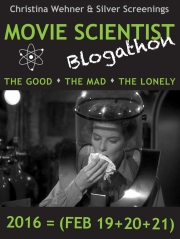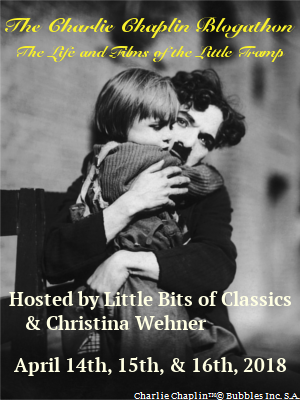 After the phenomenal success of Mrs. Miniver (Greer Garson earned an Academy Award for Best Actress), MGM re-teamed much of the cast for Madame Curie, a biopic of Marie Curie and her romance with husband/scientist Pierre Curie. The movie was inspired by the book Madame Curie: A Biography, written her daughter, Eve Curie. The role was originally intended for Irene Dunne in the late 1930s, then Greta Garbo. Finally, Greer Garson was given the role in 1943.
After the phenomenal success of Mrs. Miniver (Greer Garson earned an Academy Award for Best Actress), MGM re-teamed much of the cast for Madame Curie, a biopic of Marie Curie and her romance with husband/scientist Pierre Curie. The movie was inspired by the book Madame Curie: A Biography, written her daughter, Eve Curie. The role was originally intended for Irene Dunne in the late 1930s, then Greta Garbo. Finally, Greer Garson was given the role in 1943.
What I was surprised at was how much (reasonably) accurate science is incorporated into the movie. It is a blend of romance and scientific endeavor and apart from an excessively reverential tone, the film is surprisingly interesting and very sweet.
Marie Sklodowska (Greer Garson) is a Polish student studying in Paris in the 1890s. She’s an extraordinary dedicated and earnest student, brilliant in her work, and she is noticed by Professor Perot (Albert Basserman), who sets her up in a lab with Dr. Curie (Walter Pidgeon), a shy physicist who is at first concerned that having a woman in the lab will prove disruptive.
It is only disruptive in that Dr. Curie begins to fall in love with her and is dismayed that she intends to return to Poland and teach. He believes that she has so much to contribute to science that she ought to stay in Paris and continue her work. He also wants her to stay because he loves her, but it takes him a while to realize it.
He finally does propose, however, after having her down to his country home to meet his parents (Dame May Whitty and Henry Travers). Once married, she embarks on her doctoral work, investigating why pitchblende (ore filled with uranium and therefore radioactive) emits energy strong enough to act like light on a photographic plate. She soon discovers that once the uranium is removed from the ore – which she believes is the sole source of the radiation in the pitchblende – the ore is still radioactive. This brings her to the conclusion that there must be another, unknown and radioactive element and she and her husband set out to isolate and prove its existence.
 The process of isolating the unknown element was unbelievably laborious and the film does a good job of demonstrating this. They dissolved the ore and selectively precipitated out the different elements, one element at a time, until only the radium remained. Now, you could just put your specimen of ore under a powerful x-ray machine and determine what elements are in it.
The process of isolating the unknown element was unbelievably laborious and the film does a good job of demonstrating this. They dissolved the ore and selectively precipitated out the different elements, one element at a time, until only the radium remained. Now, you could just put your specimen of ore under a powerful x-ray machine and determine what elements are in it.
Eventually, they are able to prove the existence of radium, though the film skips their discovery of polonium (polonium is best known for being used to poison Alexander Litvineko, who had fled Russia and accused the Russian Federal Security Service of organizing a kind of coup so Putin could take power – ironic since Marie Curie named the element Polonium after her homeland, Poland, to underline the fact that Poland was not an independent country and was partly controlled by Russia).
It is a testament that the film never gets bogged down in excessive science and keeps things understandable, though it does occasionally get bogged down in too-reverential discourses on the importance of science. But what keeps the film relatable is the romance between Marie and Pierre.
Walter Pidgeon in particular brings a lot of warmth to the role and to the film. Greer Garson does well, but she is extremely earnest. She’s like George Eliot’s Dorothea Brooks and Dr. Lydgate combined. She has the saintliness and earnestness of Dorothea (she is even frequently lighted as though she were saint, with a warm glow of light on her face) and the scientific brilliance and dedication of Dr. Lydgate. But Pierre Curie, though equally brilliant, seems a bit more vulnerable, shy, devotedly in love with his wife and dedicated to working side-by-side with her. There is something so sweet in how he discovers that he no longer can imagine working or living without her. They manage the unique feat of being fully committed to their work and fully committed to each other (though as far as I can tell in the film, Pierre’s father is raising their children).
 And although it is clear that Marie also loves Pierre, it is like she doesn’t fully appreciate it until after their discovery of radium. After the intense few years of work, now her pressing work has lifted she fully sees how much she loves him…only for tragedy to strike.
And although it is clear that Marie also loves Pierre, it is like she doesn’t fully appreciate it until after their discovery of radium. After the intense few years of work, now her pressing work has lifted she fully sees how much she loves him…only for tragedy to strike.
I had always heard that Marie Curie died as a result of her work, which gave me the impression that she died particularly young. In my ignorance, I was expecting the last bit of the film to be about her wasting away a martyr to her science, but actually she lived until she was 66, though the cause of her death is believed to be related to her lifelong exposure to radiation. But it was actually Pierre who died tragically young in a traffic accident (run over by a horse and cart) when he was only 47 and she 39.
The film is much more upbeat about science than films would be after the end of WWII. It is about overcoming obstacles, dreaming great things (“to catch a star on your fingertips”), wonderment, collaboration. In Madame Curie, she speaks about cures for cancer, that “science has great beauty and, with its great spiritual strength, will in time cleanse this world of its evils, its ignorance, its poverty, diseases, wars, and heartaches.” After the end of WWII, it was “what man has wrought” and fear of the atomic bomb and an ambivalent attitude about the double-edged sword of science.
Madame Curie doesn’t seem to be watched as often as some of Greer Garson and Walter Pidgeon’s other films, but the chemistry is there and for a 1940s biopic, it’s quite detailed. They even reproduced scenes from pictures of the real Pierre and Marie Curie (their wedding day with their bikes, the clothes Marie Curie wore in the lab) and over all it has a more authentic feel than I am used to from MGM films.










Vienna
July 22, 2016 at 12:05 pm
Haven’t seen this in an age.It isn’t often written about so thanks for your review. Greer and Walter really were the perfect couple in anything they did.
LikeLiked by 2 people
christinawehner
July 22, 2016 at 1:37 pm
Yes, so true; they seem so natural and right together. It’s hard to imagine another couple in this film making their romance seem so perfect.
LikeLike
stephencwinter
July 26, 2016 at 2:23 am
I remember loving the film when I first saw it and thank you for reminding me of it. I think I loved the story of a man and a woman working together intensely on a shared task. I was young enough to have an entirely innocent understanding of science. I took people at face value. The Curies working to discover Radium or Spencer Tracey’s Edison trying to make an electric light bulb that would work. I loved a tale of enterprise and passion overcoming all obstacles. I still look for this quality in a young person.
LikeLiked by 1 person
christinawehner
July 26, 2016 at 10:33 am
There is something extremely lovely about how those two worked together so closely and intensely to overcome! I’ve always been a bit in awe of people with the conviction and dedication to devote their lives to something to that extent. And the love story, as you say, makes the the film even more special because they share that conviction and dedication together.
LikeLiked by 1 person